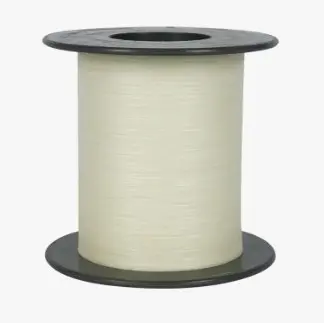In the modern textile industry, metallic yarn, with its unique decorative effects and functional properties, has gradually risen from a supporting role to a mainstream material. Whether in fashion apparel, high-end home textiles, or functional industrial fabrics, metallic yarn is being widely used, continuously driving innovation in textile design and technology.
Metallic Yarn Composition and Basic Processing
Metallic yarn differs from ordinary fibers in that it is essentially a composite yarn that possesses metallic luster, conductivity, or reflectivity by physically or chemically combining metal materials with other fibers. Its core structure is often a multi-layered sandwich structure. The outermost layer is typically a metal film or an aluminized polyester film, the middle layer is a supportive base fiber, and the bottom layer is an adhesive layer to ensure overall flexibility and strength.
Currently, there are three main manufacturing methods: coating, lamination, and spraying. The coating method involves wrapping metal filaments or film-like materials around the core fiber, creating a yarn with a shimmering appearance and a soft feel. The lamination method involves attaching a metal film to a plastic film, which is then cut into thin filaments to form yarn. The spray coating method, on the other hand, uses high-precision vacuum coating technology to deposit a metal layer directly onto the surface of a film or fiber. The differences in these processes directly determine the performance and application suitability of the yarn.

Material Systems and Functional Properties of Metallic Yarns
In terms of material selection, metallic yarns can be made from various metals, such as aluminum, silver, stainless steel, and copper. Key differences lie in the purity and thickness of the metal layer, as well as the fusion technology used with the substrate. Aluminum is the most common choice due to its light weight, high reflectivity, and low cost. In the high-end market, silver-plated yarns are widely used in smart textiles and medical protection due to their excellent electrical conductivity and antibacterial properties.
Metallic yarns not only offer excellent visual decorative effects, but also demonstrate outstanding performance in heat reflection, electromagnetic shielding, and thermal and electrical conductivity. Flexibility, washability, and processing stability are key indicators for evaluating their practical usability. By combining with polyester, nylon, spandex, and other fibers, the yarn's weavability and wearability can be further enhanced, allowing it to be flexibly adapted to various technical systems, including knitting, weaving, and embroidery.
Metallic yarns' diverse applications: The fusion of fashion and function.
Initially used primarily for apparel embellishment and festive decoration, metallic yarns have expanded into multiple high-end industrial chains with the advancement of craftsmanship and the diversification of materials. In fashion design, metallic yarns are widely used in haute couture dresses, stage costumes, and performance costumes, creating dynamic aesthetics through the refraction of light and shadow.
Metallic yarns also demonstrate strong potential in home and architectural decoration, particularly in large-area materials like curtains, tablecloths, and wall coverings, where their UV resistance, light reflection, and antibacterial properties are highly valuable. In the field of functional textiles, metallic yarns have become a key component of smart textiles and wearable devices, enabling functions such as heart rate monitoring, temperature sensing, and EMI shielding. They provide multi-dimensional technical support for industries such as medical, military, and aerospace.
Metal yarns are also gradually entering the industrial sector, being used to manufacture antistatic and fire-retardant fabrics, filter materials, and other materials, enhancing the stability and safety of industrial products. Their role in composite materials is also gaining increasing attention, particularly in lightweight structures and high-strength fabrics, where they show great potential.

From Materials to Concepts: Metal Yarns Lead the Trend of Sustainable Innovation
With the rise of global environmental awareness, the metal yarn industry faces challenges in material sustainability and recycling rates. Traditional metal yarns consume significant resources and energy during production, and some also contain heavy metal residues and are difficult to degrade. Consequently, the industry is exploring innovative approaches such as biodegradable coatings, green synthetic substrates, and low-energy coating processes to advance metal yarns towards a new stage of environmental friendliness and high performance.
Furthermore, the introduction of digital process control and intelligent manufacturing platforms is also improving the production precision and cost control of metal yarns. By applying new technologies such as digital printing, 3D knitting, and parametric simulation, designers and engineers can more efficiently visualize and mass-produce complex structures, providing more innovative and functional solutions for the high-end market.
Future Outlook: Strategic Layout and Market Prospects for Metallic Yarns
As the consumer market continues to shift towards high-quality and high-functionality, metallic yarns will no longer be merely decorative elements but will become core components in the matrix of functional textile materials. In particular, metallic yarns will continue to play an irreplaceable role in smart wearables, personalized customization, protective equipment, and the construction of future urban spaces.
Technologically, metallic yarns will be further optimized in terms of ultrafineness, flexibility, and integration to meet the demands of higher-precision weaving and electronic integration. In terms of market expansion, the growing demand for highly reflective and heat-resistant materials in emerging markets such as the Middle East and Southeast Asia will provide new impetus for metallic yarn exports. Regarding sustainable strategies, the development of green and low-carbon production systems will become a new focus of corporate competitiveness.
Metallic yarns are not only the product of materials engineering but also the crystallization of textile aesthetics and technological imagination. With their unique luster, texture, and functionality, they redefine the expressiveness and application boundaries of modern textiles. In the future wave of integrated, intelligent, and environmentally friendly textile development, metallic yarns, with their unique material language, will write a richer and more profound chapter in the industry.

 English
English русский
русский Español
Español











